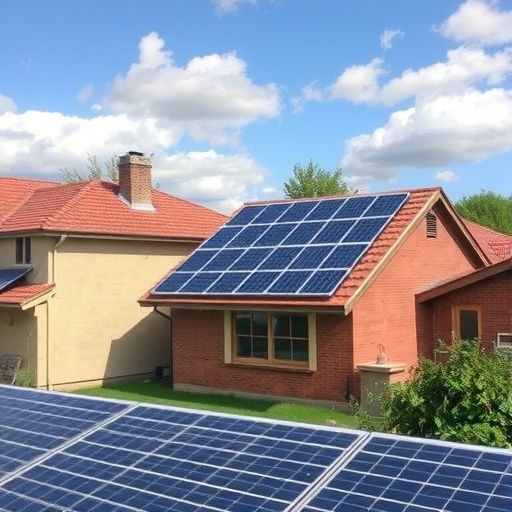In recent years, the conversation surrounding renewable energy has intensified, especially as more households transition to solar panel installations. In Australia, where sunlight abounds and renewable adoption is high, researchers have underscored an intriguing opportunity for solar-powered homes: peer-to-peer (P2P) energy sharing. This innovative approach allows households to sell surplus energy directly to their neighbors, instead of relying on traditional electricity retailers, facilitating not only personal financial benefits but also fostering grid stability.
Statistics reveal a significant global momentum, with approximately 25 million households worldwide currently using solar panels. Yet, projections indicate an astonishing rise to 100 million installations by the year 2030. The projections for solar power installations have been equally impressive, with an estimated 597 gigawatts added globally in 2024 alone, reflecting an astounding 33 percent increase compared to the previous year. Against this backdrop, Australia has emerged as a leader in solar energy uptake. Nearly 40 percent of households across the nation—around 4.1 million homes—are equipped with solar panels, showcasing the country’s commitment to renewable energy.
.adsslot_9hJbRckUNy{ width:728px !important; height:90px !important; }
@media (max-width:1199px) { .adsslot_9hJbRckUNy{ width:468px !important; height:60px !important; } }
@media (max-width:767px) { .adsslot_9hJbRckUNy{ width:320px !important; height:50px !important; } }
ADVERTISEMENT
In response to these pressing challenges, the Australian government has initiated a $2.3 billion program aimed at promoting the installation of home batteries. The hope is that enhanced storage capabilities will allow households to make better use of their generated solar power. However, recent research indicates that simply adding battery storage may not yield beneficial outcomes for every household. Studies conducted collaboratively between the University of South Australia and Deakin University examined four energy models focused on improving the efficiency of community-based solar systems through different configurations of energy distribution.
These models included options like peer-to-grid (P2G), which involves exporting excess energy back to the grid; P2G with battery storage, allowing for the temporary holding of surplus energy before selling it to the grid; a direct neighbor-sharing model dubbed peer-to-peer (P2P); and P2P coupled with battery storage that accommodates both personal consumption and neighborly sharing. The results demonstrated clear benefits associated with P2P energy sharing, especially under circumstances where feed-in tariffs are notably low, like those currently observed in Victoria.
Lead researcher Dr. Kevin Wang emphasized the financial potentials of P2P interactions, stating that at present, the feed-in tariff stands at less than five cents per kilowatt-hour, while the average retail price hovers around 28 cents. This discrepancy presents a lucrative opportunity for solar owners to negotiate mutually beneficial pricing for surplus energy exchanged with neighbors, creating an avenue for profit that escapes the constraints of traditional energy sales.
This model of localized energy sharing not only provides economic incentives but contributes to overall grid stability as well. By engaging in P2P transactions, solar households help regulate energy supply and demand, mitigating the overflow of surplus energy directed toward the grid, which is primarily designed for energy distribution rather than reception. This approach turns former excess into an asset—contributing to a more sustainable local energy economy.
The research findings revealed multiple implications regarding batteries and energy sharing constructs. For instance, while the introduction of a 5kWh battery enhanced self-consumption levels to 22 percent and reduced reliance on the grid, it failed to generate additional profit for the homeowner, revealing the high initial costs associated with battery purchase. In stark contrast, those households engaging in P2P energy sharing experienced over a 30 percent decrease in their overall grid electricity usage, pointing to the model’s potential for community support and resource optimization.
Interestingly, the study illustrated that without the inclusion of batteries or P2P energy transactions, households exported nearly 12,800 kWh to the grid annually, with a self-consumption rate languishing at just 14.6 percent. This highlights how traditional practices could leave homeowners financially vulnerable, emphasizing the need for more dynamic, community-oriented solutions.
The dynamics changed significantly when battery storage was added to the P2P framework, as households realized nearly 38 percent in self-consumption rates. However, this system also limited the surplus energy available for neighboring consumption due to battery charging priorities. The desired equilibrium between energy storage and sharing remained a pivotal question throughout the research, as researchers tried to navigate the dichotomy of personal benefit versus community resource sharing.
Sensitivity analyses conducted during the study showed that market variables—including equipment costs, discount rates, and energy-sharing prices—significantly affected the financial sustainability of photovoltaic battery systems. Therefore, a deeper understanding of market mechanics will be essential as households look to capitalize on these new energy sharing opportunities.
Ultimately, researchers developed a clear recommendation for setting P2P energy sharing prices. They noted that if pricing can be strategically established between current feed-in tariffs and retail rates, both sellers and buyers would stand to gain financial benefits. However, to realize this potential broadly, foundational market rules and technical frameworks must evolve to support successful large-scale energy transactions.
As the journey toward low-carbon energy systems continues, the insights gleaned from this research are poised to inform legislative and investment decisions that can further build momentum in the energy sector. For Australia’s leading role in adopting solar energy technologies, the integration of P2P energy sharing could frame a foundational narrative for future advancements in residential energy economics.
By embracing these collaborative, community-based models, the era of decentralized energy—a hallmark of sustainable development—might be closer than we think.
Subject of Research:
Article Title: Technical and economic analyses of grid-connected residential PV considering batteries and peer-to-peer energy sharing
News Publication Date: 26-May-2025
Web References: Journal link
References: DOI: 10.1016/j.renene.2025.123494
Image Credits:
Keywords
Renewable Energy, Peer-to-Peer Energy Sharing, Solar Power, Grid Stability, Residential PV Systems, Battery Storage, Australian Energy Policy.
Tags: Australia solar power marketcommunity solar initiativesfuture of renewable energygrid stability solutionshousehold energy independenceneighborhood energy collaborationpeer-to-peer energy tradingrenewable energy benefitssolar energy challengessolar energy sharingsolar panel adoption statisticssurplus energy selling





